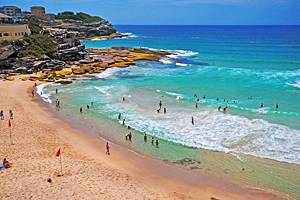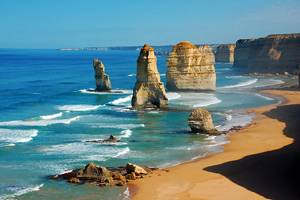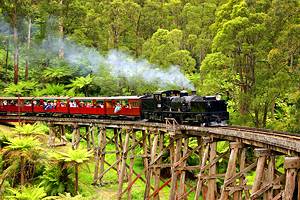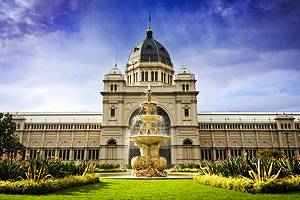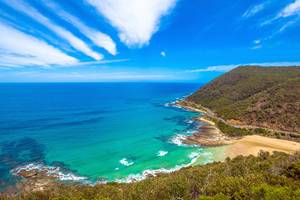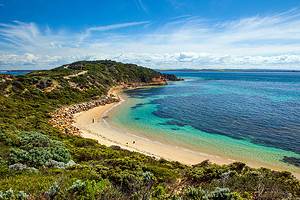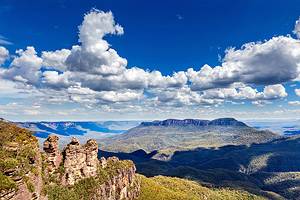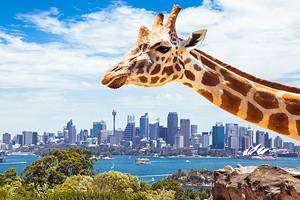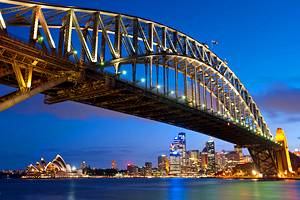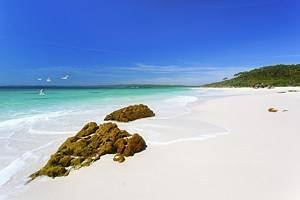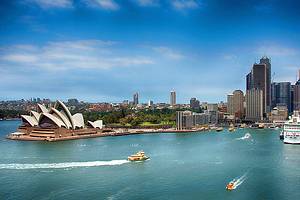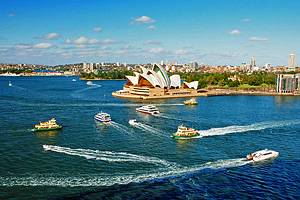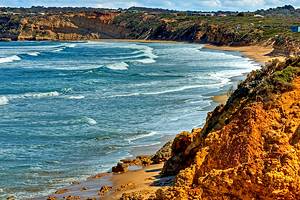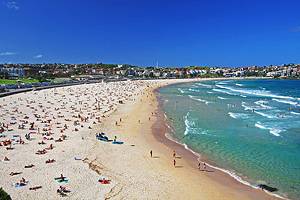Attractions in the Snowy Mountains, NSW
Part of the Great Dividing Range, the spectacular Snowy Mountains encompass the highest peaks in Australia, with activities and attractions for every season. At 2,228 meters, Mount Kosciuszko is the granddaddy of them all, presiding over a land of wind-whipped plateaus, alpine heathlands, snow gum forests, meadows, mighty rivers, and vast mountain lakes.
Rising to the southwest of Canberra, near the border with Victoria, the Snowy Mountains are a popular playground for nature lovers and sports enthusiasts year-round. Favorite things to do in winter in the Snowy Mountains include downhill skiing, cross-country skiing, and snowboarding at some of Australia's top ski resorts, including Perisher, Thredbo, and Charlotte Pass. All the winter sports resorts in the Snowy Mountains lie within Kosciuszko National Park and are easily accessible, with top-notch facilities.
You'll also find plenty of things to do in summer in the Snowy Mountains. Outdoor enthusiasts come here to play in the fresh, clean air, and indulge in activities like hiking, climbing, water skiing, rafting, kayaking, and mountain biking. You can also fly fish for trout in the crystalline rivers, lakes, and streams, including Lake Jindabyne, one of Australia's top fishing destinations. Budding mountaineers can even summit the continent's highest peak.
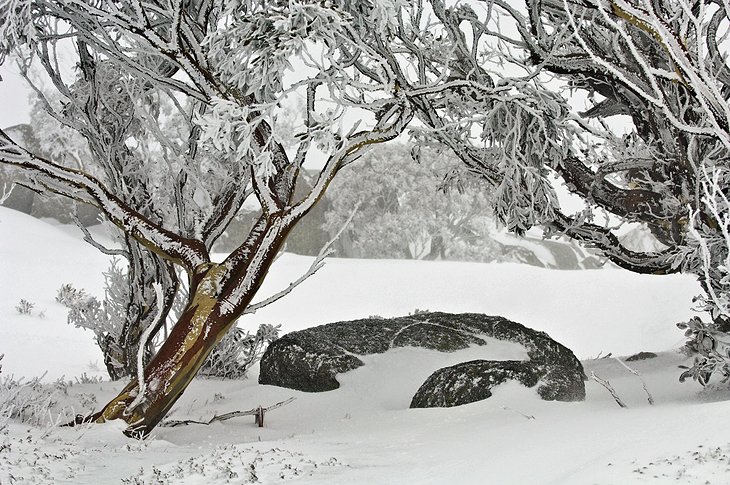
The best time to visit the Snowy Mountains depends on your interests. Winter sports usually run from the end of May/ beginning of June until the middle or end of October, depending on snowfall. Summer activities are best from December through February, but it's also beautiful in the Snowy Mountains in autumn and spring, when you can soak up the scenery without the high-season tourists.
Discover the best places to visit in all four seasons with our list of the top attractions of the Snowy Mountains, NSW.
Kosciuszko National Park
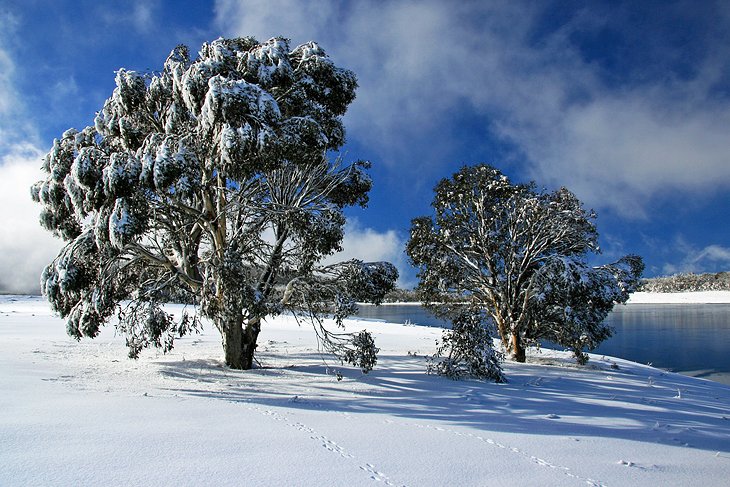
Magnificent Kosciuszko National Park is a magnet for nature lovers and outdoor adventurers. The park covers 6,000 square kilometers of snow-capped peaks, alpine meadows, limestone gorges, snow gum forests, and the headwaters of the mighty Snowy River.
Mount Kosciuszko, the highest mountain in Australia at 2,228 meters, also lies within the park, and the park plays host to Snowy Mountains skiing with some of Australia's top ski resorts. The snow lies for months in the winter, luring snowboarders, skiers, and snowshoers.
In summer, when the snow melts, wildflowers speckle the heathlands, and you can explore the beautiful scenery on hiking trails. One of the most popular is the Kosciuszko Walk, which takes you up to the summit of the continent's highest peak, Mount Kosciuszko, in less than five hours round trip.Other popular things to do in summer include rock climbing, mountain biking, fishing, camping, and kayaking.
Another top tourist attraction in the park is Yarrangobilly Caves, five limestone caverns with stalagmites, stalactites, and other bizarre formations. After exploring the caves, you can soothe any sore muscles by taking a dip in the thermal pool.
In summer, all roads into this mountainous region are open. During winter, snow chains must be fitted on some roads within the park from June 1st to October 10th, and some roads may be completely closed during this time.
The resort town of Jindabyne is a great base for exploring the park.
Official site: http://www.nationalparks.nsw.gov.au/visit-a-park/parks/Kosciuszko-National-Park
Kosciuszko Walk
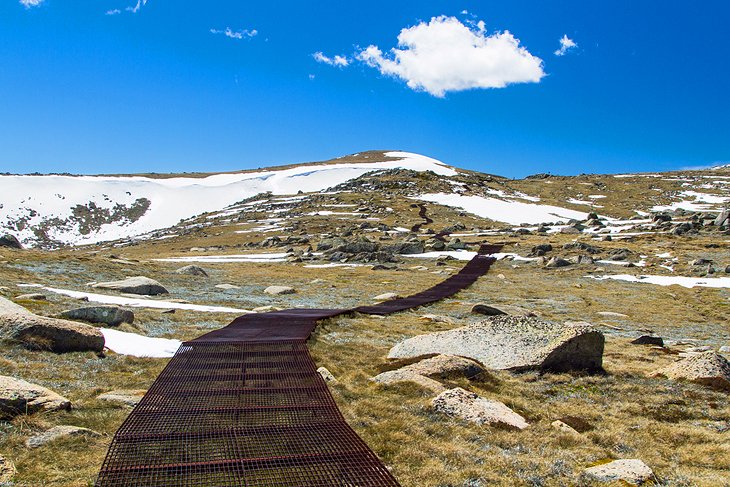
Ever wanted to summit a continent's highest mountain, even though you're not much of a climber? This is your chance. You can hike to the top of 2,228-meter Mount Kosciuszko in a couple of hours, with a little help from Thredbo's Kosciuszko Express Chairlift. Zooming up to the trailhead on the chairlift shaves two to three hours off the journey and makes this summit doable for even beginner hikers. It's a Grade 3 trail, meaning it's suitable for most ages and fitness levels.
Once you hop off the five-minute chairlift, the 13-kilometer hike takes you through the rugged Ramshead Range, through heathlands flecked with wildflowers in the spring, and past glacier-carved Lake Cootapatamba. Your reward? Spectacular views of Australia's alpine country in all directions-and, best of all, no altitude sickness!
One of Australia's top hikes, Kosciuszko Walk takes about five hours round-trip from the top of the chairlift and is best tackled during the summer months. It might not be as high as Everest, but standing on the summit, gazing out across the rippling terrain, you'll still feel as though you're on top of the world, or at least on top Down Under.
Perisher Ski Resort

In Kosciuszko National Park, Perisher Ski Resort is one of the top ski resorts in Australia, with a total of more than 3,000 acres of interconnecting skiable terrain. The resort encompasses Perisher Valley, Smiggin Holes, Guthega, and Mount Blue Cow resorts, all of which were previously separate. Together, they form the largest ski resort in the Southern Hemisphere.
At 1,720 meters above sea level, Perisher offers a range of Snowy Mountains accommodation, as well as restaurants, cafés, and shops. Visitors here can enjoy both alpine and cross-country skiing, as well as snowboarding.
The Skitube, a Swiss-designed train, runs through a tunnel between Perisher Valley and Mount Blue Cow, and ski trails and chairlifts connect the other resorts.
Official site: http://www.perisher.com.au/
Thredbo Village
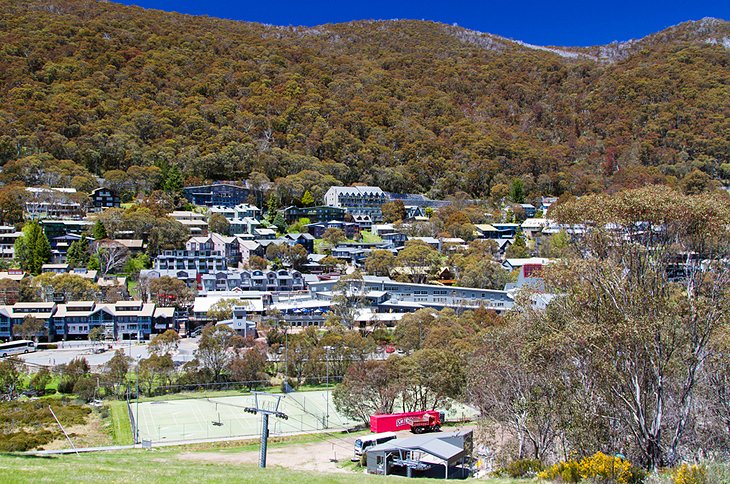
At the foot of the Crackenback Range in Kosciuszko National Park, Thredbo Village exudes a charming European-style ambience. It also offers the best steeps and vertical runs of all the state's ski resorts, including the 3.7-kilometer-long Supertrail, Australia's longest run. In the winter, skiers and boarders can play on more than 1,186 acres, with runs for all levels, including four terrain parks, and the resort also offers a top-notch giant slalom course.
Summer brings even more outdoor activities. Mountain bikers and hikers take advantage of the Kosciuszko Express Chairlift, which runs year-round to the summit of Mount Crackenback. From here, you can hike to the summit of Australia's highest peak on the Kosciuszko Walk.
Another popular hike is the Thredbo River Track, which takes you through the village along the banks of this scenic waterway. Other popular things to do in summer include golf, tennis, swimming, and fly fishing.
Thredbo Village is well equipped with facilities for visitors, including many chic restaurants, lodges, day spas, and entertainment venues, and if you prefer indoor activities, you can head to the Thredbo Leisure center for swimming, trampolining, basketball, squash, and much more.
Snowy Mountains holiday packages with accommodation and lift tickets make visiting Thredbo cheaper, especially during spring.
Official site: https://www.thredbo.com.au/
Charlotte Pass
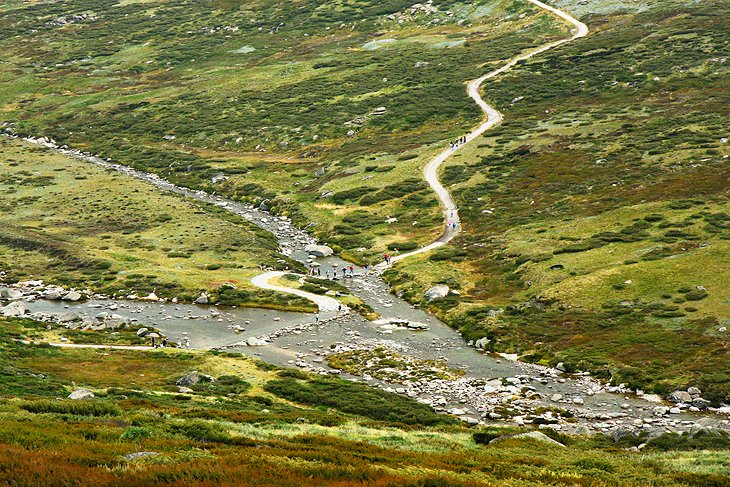
Perched near the summit of Mount Kosciuszko, Charlotte Pass is the highest resort in Australia. At 1,760 meters, it's a great base for ski tours to the highest peaks in the Australian Alps and is often the venue of ski competitions.
The resort was named for Charlotte Adams, the first European woman to climb Mount Kosciuszko in 1881. Today, skiers and snowboarders will find runs to suit all abilities here, from gently rolling beginner slopes to expert chutes. Due to its high altitude, it also offers among the most reliable snowfall of all Australia's ski resorts.
In the summer, hikers come here to ascend the summit of Mount Kosciuszko, an 18-kilometer round-trip, or hike the Main Range Walk, which threads past glacial lakes and offers spectacular views.
Access to the resort in winter is via a snowcat from Perisher Valley. In summer, your can make the 40-minute drive from Jindabyne.
Official site: http://www.charlottepass.com.au/
Jindabyne
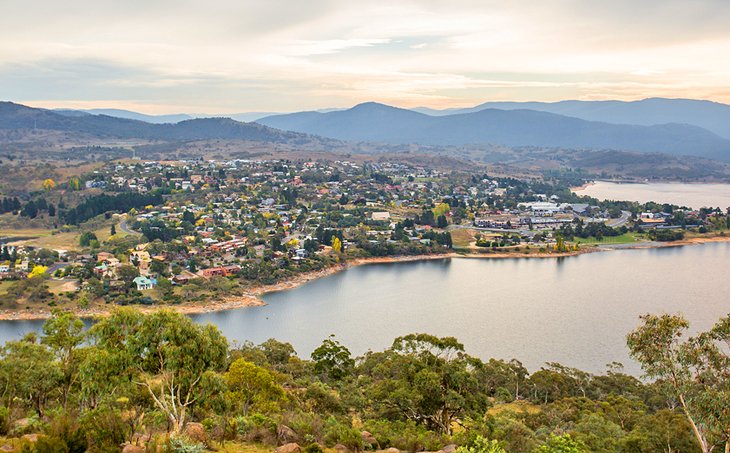
Jindabyne, a new settlement on the shores of Lake Jindabyne, makes a great base for trips to Kosciuszko National Park. In the 1960s, the damming of the Snowy River under the Snowy Mountains hydro-electric scheme submerged the town's original site, and when lake levels are low, the remains of the old town are sometimes still visible. To get a feel for the lay of the land, head to Waste Point Lookout for panoramic views over the lake and its surroundings.
A great first stop in Jindabyne is the Snowy Region Visitor Center. Here, you can learn more about the area's history, aboriginal heritage, and ecology, and the staff also provide maps, information on where to stay, and sightseeing tips. If you're planning on visiting Kosciuszko National Park, this is a great place to purchase a pass.
Jindabyne's accommodation tends to be more affordable than other Snowy Mountain destinations-especially during winter. When the snow falls, hordes of skiers and snowboarders make Jindabyne their base and catch a shuttle bus to the slopes of Perisher Valley and Smiggin Holes.
In summer, kayaking, bush walking, mountain biking, white water rafting, and horseback riding are popular wilderness adventures. Anglers can cast a line for trout in the lake and visit the Gaden Trout Hatchery to learn about the fish stocking of local waterways.
After the snow melts, it's possible to drive to Charlotte Pass, a great base for climbing Mount Kosciuszko.
Lake Jindabyne
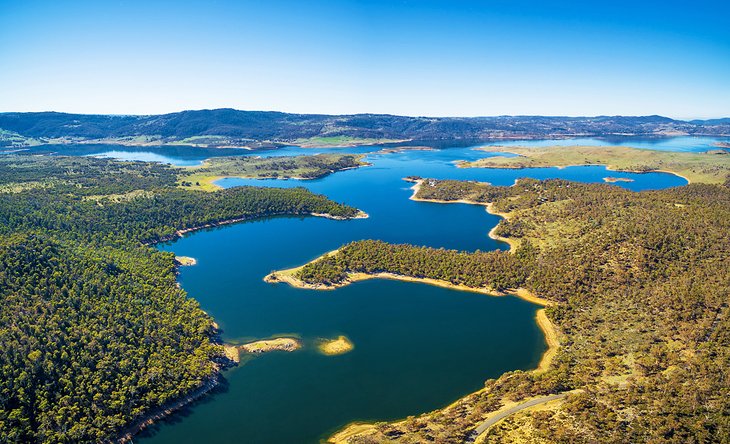
Lake Jindabyne is one of the state's largest freshwater reservoirs and a year-round playground for outdoor enthusiasts. This sparkling blue waterway is the focal point of the resort town of Jindabyne, which was relocated here when the Snowy River was dammed in the 1960s.
Walking and cycling tracks ring the lake, creating a scenic way to keep fit, and the open green spaces are prime picnicking spots. For those who prefer to be on the water, kayaking, canoeing, and power boating are popular things to do.
The lake is also one of the best fishing spots in Australia, with opportunities to catch Atlantic salmon, brown trout, brook trout, and rainbow trout.
During the Easter holidays, a Lake Light Sculpture exhibition takes place here along the foreshore.
Cooma
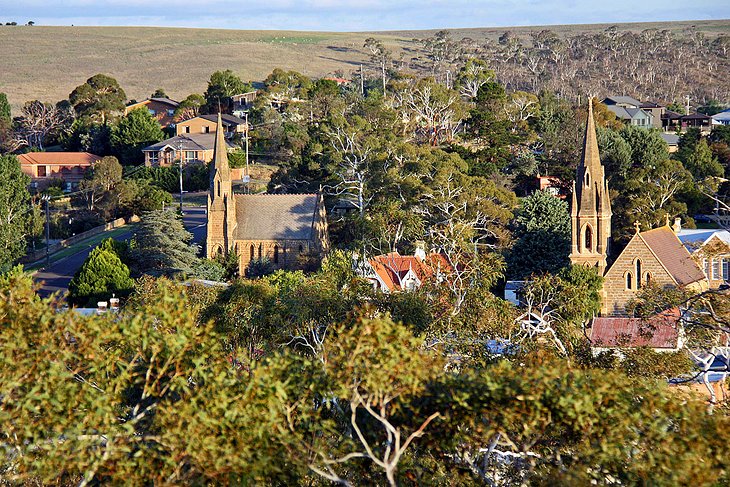
Snuggled at the junction of the Monaro and Snowy Mountains highways, Cooma is the largest town in the region and a gateway to the surrounding alpine wilderness.
Cooma was established in 1849, but it was the discovery of gold in 1859 at Kiandra, 90 kilometers west, that spurred the development of the town. When the Snowy Mountains hydro-electric scheme was under construction in the 1950s and 1960s, the town's population swelled with the influx of workers. The Avenue of Flags in Centennial Park displays the flags of the 27 nationalities of the workers.
Today, visitors can explore the town's rich heritage along the Lambie Town Walk, where 19th- and 20th-century buildings sit side by side with art galleries and cafés. Stop by the Raglan Gallery Cooma to see the works of local artists, and for the best views of the surroundings, head to Mount Gladstone Lookout.
Another must-see in Cooma is the Snowy Hydro Discovery Centre, where you can learn about one of Australia's most important infrastructure projects through interactive exhibits and movies. The center is also home to a great little café.
Cooma Visitor Centre is also worth a stop for helpful tips on things to see and do, and the Corrective Services NSW Museum traces the surprisingly interesting history of Australia's prison system, for a small donation.
Anglers will enjoy a visit to Eucumbene Trout Farm, where you can fish for trout in the ponds and enjoy your freshly-cooked catch for lunch. South of Cooma, on the Monaro Highway, Bombala offers excellent trout fishing.
Alpine Way Scenic Drive
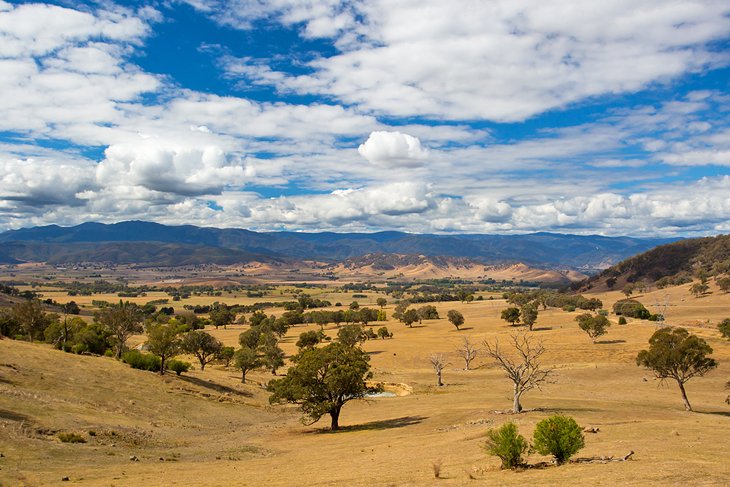
Want to see the highlights of Australia's only alpine region? Head out on the Alpine Way. This 108-kilometer one-way scenic drive twists and climbs on narrow mountain roads between Khancoban and Thredbo, through southern Kosciuszko National Park.
Along the way, you'll see alpine lakes and rivers, flower-flecked meadows, and magnificent mountain scenery. Fly fish for trout in the vast mountain lakes, horseback ride among the heathlands, hike scenic trails, and browse the shops and galleries at Thredbo Village.
Official site: https://www.nationalparks.nsw.gov.au/things-to-do/driving-routes/kosciuszko-alpine-way-drive
Mount Selwyn
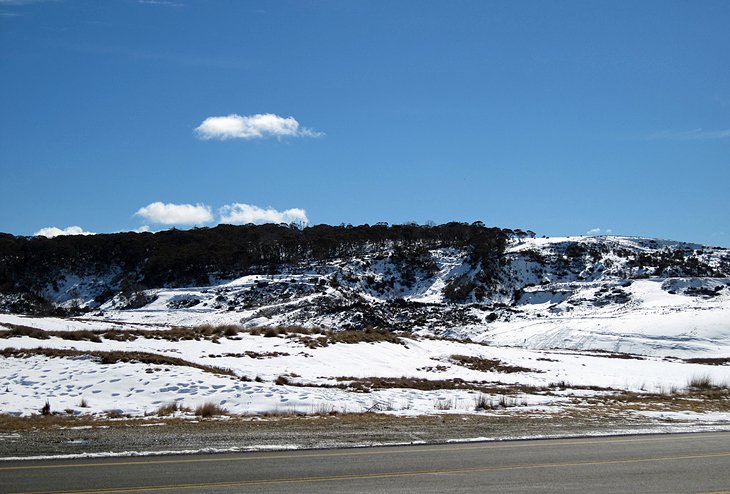
About an hour drive from the town of Tumut, this skiing area at the northern end of Kosciuszko National Park is best suited to beginners and families. Mount Selwyn is also a popular place for cross-country skiing, and the resort also offers tobogganing and snowshoeing.
This is a family-run resort with limited amenities, so you won't find chic restaurants and shops here, but it offers good value for families looking for an affordable first-time ski experience.
If you're looking for a place to stay nearby, Adaminiby, Old Adaminaby, and Anglers Reach are the closest options.
Wadbilliga National Park
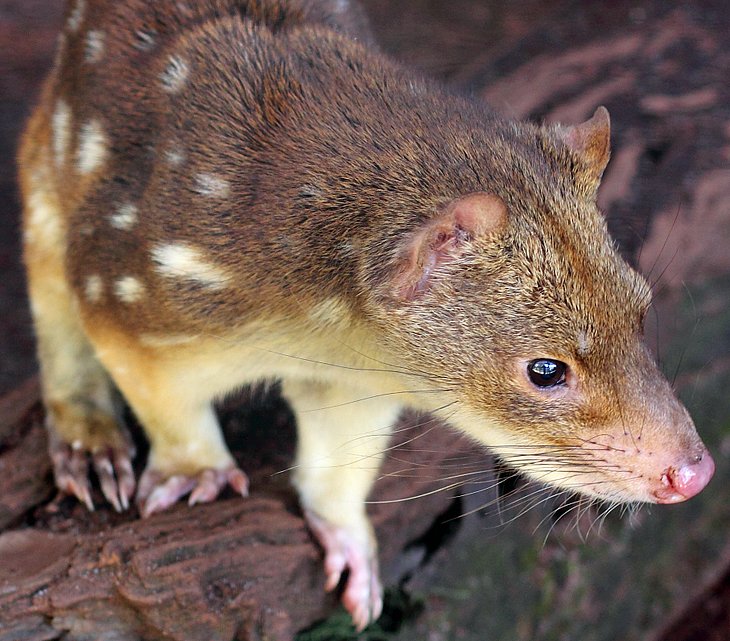
About 40 kilometers from Cooma, Wadbilliga National Park takes in the unspoiled catchment areas of the Brogo and Wadbilliga Rivers. In the northwest of the park, waterfalls tumble over the rocky cliffs into the impressive Tuross River Gorge.
The western part of the park is a region of tall eucalyptus forest and great expanses of heathland. Bush camping and hiking are popular in the Brogo and Wadbilliga valleys, and the park is excellent for mountain biking, with granite cliffs and rolling plateaus.
The abundant wildlife includes species such as the endangered spotted-tailed quoll, pythons, and sooty owls, and you also have a chance to spot sugar gliders at night.
Official site: http://www.nationalparks.nsw.gov.au/visit-a-park/parks/Wadbilliga-National-Park
Tips and Tactics
- During winter, chains are required to be carried at all times for 2WDs.
- Always check road conditions before departure by calling the RTA Hotline on 132 701 or check the Live Traffic NSW website.
- If you want to minimize driving time, you can fly into Canberra airport, and from here it's a 2.5-hour drive to the Snowy Mountains.
Map of Attractions in the Snowy Mountains, NSW
More Related Articles on PlanetWare.com
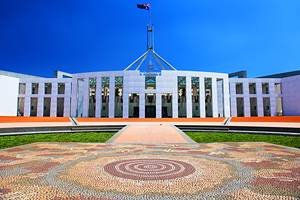
See More of New South Wales: The Snowy Mountains in New South Wales are a wonderland for winter sports. For information on the best places to hit the slopes, see our article on the Ski Resorts in Australia. Looking for a dose of culture after your wilderness adventures? Drive 2.5 hours to Canberra, the nation's capital, set on beautiful Lake Burley Griffin. Here, you can explore some of the country's best museums, memorials, and galleries, as well as Old and New Parliament House. And if you want to see more of this diverse Aussie state, check out the best places to visit in our article on the Tourist Attractions in New South Wales (NSW).


